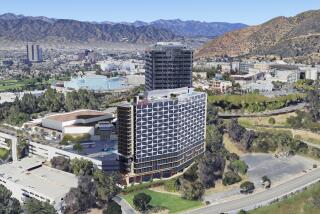Cooperation Is NoHo Key
North Hollywood may be just over a year away from the rebirth that has eluded it for so many years. Next summer, the Metro Red Line extension to North Hollywood opens, giving residents and workers a quick, easy ride to Hollywood and downtown. And on Thursday, the board of the Community Redevelopment Agency considers entering into exclusive negotiations with a developer who wants to build a studio and commercial complex in the heart of the NoHo arts district. Both projects should help boost the core of North Hollywood, which has sagged despite intense renewal efforts.
Two Red Line stations are scheduled to open in the San Fernando Valley in May 2000, one in Universal City and the other just up Lankershim Boulevard in North Hollywood. Earlier this month, the Metropolitan Transportation Authority unveiled the Universal City station to show off what will most likely be one of the last two subway stops built in Los Angeles County for the foreseeable future. Like all stations in the subway system, the Universal City stop is a beauty that reflects bits of its surroundings. Built beneath the site where the treaty ending the Mexican-American War was signed, the station includes engravings that tell the story of the events leading to a truce. Colorful tiles will also picture famous people from California’s past.
Farther up Lankershim, across the street from the North Hollywood station, a developer wants to build a studio and commercial project that includes sound stages, restaurants, offices, stores and condominiums. It’s just the sort of project that belongs next to a subway stop and just the sort of project that holds the potential to transform North Hollywood. A CRA committee recommended pursuing the plan because, of two competing proposals, it appeared to be the one most likely to work without much city assistance. In fact, the CRA plans to limit its aid to helping J. Allen Radford assemble the 42 acres he needs. Some business owners are understandably worried that the agency will use its power of eminent domain to force out viable businesses. Every effort should be made to assemble the property with as little condemnation as possible.
Big plans and a fancy rail system--these are ingredients for success. But they cannot be taken for granted. Plans can fail and rail lines can sit unused unless developers, transit groups, residents, city officials and business owners work together to create an environment in which growth and change can occur.
More to Read
Sign up for Essential California
The most important California stories and recommendations in your inbox every morning.
You may occasionally receive promotional content from the Los Angeles Times.










